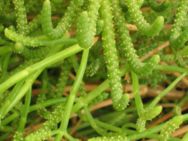Difference between revisions of "Food/Seawater-irrigated farming"
From AdCiv
< Food
(New page: It is possible to create a viable farm using seawater instead of fresh water, by growing {{wp|Halophyte|salt-loving plants}} like salicornia for human consumption and mangrove as...) |
|||
| (5 intermediate revisions by the same user not shown) | |||
| Line 1: | Line 1: | ||
| − | It is possible to create a viable farm using seawater instead of [[Water|fresh water]], by growing {{wp|Halophyte|salt-loving plants}} like salicornia for human consumption and mangrove as livestock feed. Shrimp and other aquatic animals can be farmed in tanks, enriching the water with their effluent. In the past ten years or so, seawater farms like this are starting to flourish in North Africa and Mexico, turning arid coastal deserts into self-sufficient productive land. This could be applied along as much of the world's 40,000km of coastal deserts as is needed. This is enough new farmland to feed hundreds of millions of people. | + | [[Image:Salicornia.jpg|right|thumb|188px|Salicornia will readily grow in saltwater-irrigated land and can form the basis for an ecosystem there.]]It is possible to create a viable farm using seawater instead of [[Water|fresh water]], by growing {{wp|Halophyte|salt-loving plants}} like {{wp|Salicornia|salicornia}}, {{wp|Batis|batis}} and {{wp|Distichlis_palmeri|Palmer's grass}} for human consumption and mangrove as livestock feed. Shrimp and other aquatic animals can be farmed in tanks, enriching the water with their effluent. In the past ten years or so, seawater farms like this are starting to flourish in North Africa and Mexico, turning arid coastal deserts into self-sufficient productive land. This could be applied along as much of the world's 40,000km of coastal deserts as is needed. This is enough new farmland to feed hundreds of millions of people. |
In the near future, it may even be possible to genetically engineer common food plants to grow in salty water <sup>[http://www.shef.ac.uk/aps/mbiolsci/jeni/dissertation.pdf]</sup> | In the near future, it may even be possible to genetically engineer common food plants to grow in salty water <sup>[http://www.shef.ac.uk/aps/mbiolsci/jeni/dissertation.pdf]</sup> | ||
| Line 6: | Line 6: | ||
* [http://www.youtube.com/watch?v=_P1rPnVUME4 Greening Eritrea] | * [http://www.youtube.com/watch?v=_P1rPnVUME4 Greening Eritrea] | ||
* [http://www.seawaterfoundation.org/ The Seawater Foundation] | * [http://www.seawaterfoundation.org/ The Seawater Foundation] | ||
| + | * [http://www.miracosta.edu/home/kmeldahl/articles/crops.pdf ''Irrigating Crops with Seawater''] - Scientific American article from 1998 | ||
Latest revision as of 18:30, 29 June 2013
It is possible to create a viable farm using seawater instead of fresh water, by growing salt-loving plants
 like salicornia
like salicornia  , batis
, batis  and Palmer's grass
and Palmer's grass  for human consumption and mangrove as livestock feed. Shrimp and other aquatic animals can be farmed in tanks, enriching the water with their effluent. In the past ten years or so, seawater farms like this are starting to flourish in North Africa and Mexico, turning arid coastal deserts into self-sufficient productive land. This could be applied along as much of the world's 40,000km of coastal deserts as is needed. This is enough new farmland to feed hundreds of millions of people.
for human consumption and mangrove as livestock feed. Shrimp and other aquatic animals can be farmed in tanks, enriching the water with their effluent. In the past ten years or so, seawater farms like this are starting to flourish in North Africa and Mexico, turning arid coastal deserts into self-sufficient productive land. This could be applied along as much of the world's 40,000km of coastal deserts as is needed. This is enough new farmland to feed hundreds of millions of people.
In the near future, it may even be possible to genetically engineer common food plants to grow in salty water [1]
See also —
- Greening Eritrea
- The Seawater Foundation
- Irrigating Crops with Seawater - Scientific American article from 1998
